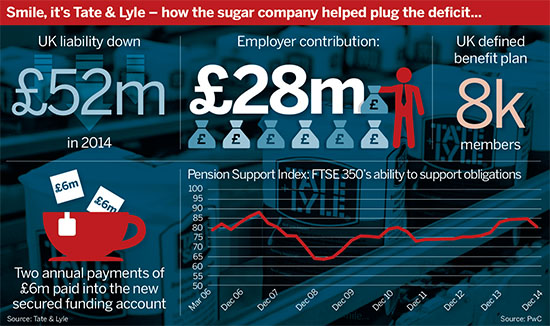Sugar company Tate & Lyle reduced its defined benefit liability by £52m in 2014, helped by the creation of a secured funding account as a contingency to its core employer contributions.
Cash contributions into escrow accounts and asset-backed funding arrangements are on the rise as employers look for ways to plug deficits without the risk of trapping surpluses.
In March, the Rentokil Initial Pension Scheme set up an escrow account to prevent employer contributions becoming trapped in the scheme, after its funding level reached surplus.
Tate & Lyle’s latest annual report, published in May, showed its main UK pension scheme liability decreased £52m during 2014 despite a lower discount rate. This was attributed in part to strong asset performance and was boosted by a total employer contribution of £28m.
Following the 8,000-member scheme’s March 2013 triennial valuation, trustees set up the secured funding account with the employer last year. In addition to core employer contributions of £12m a year, the funding arrangement includes a contingent mechanism whereby supplementary contributions of £6m a year will be made for six years in the event of certain triggering scenarios.
They’ve gone quite some way in contingency planning
Julia Dickson, PwC
The company will pay this amount if the scheme’s investments underperform or if there is a deterioration in the strength of the sponsor covenant.
The report stated: “The first two annual payments amounting to £12m were credited to the secured funding account upon its establishment in October 2014 and have been accounted for as additional contributions to the scheme in the second half of the year.”
DB-DC transfer risk
Darren Masters, head of covenant consulting at Mercer, said many cash and asset-backed funding arrangements currently in place may not have considered the longer-term impact of a high volume of transfers out of DB schemes under new pension freedoms.
Masters said outward transfers could have a significant impact on schemes' cash and liability profiles, giving rise to a need for divestment and additional scheme funding.
"It could be a bit of a double-edged sword. It’s a bit too early to tell what extent of transfers we’re going to see out, [we're] not sure how many of these structures we have in place that really recognise and work with the new freedoms."
Alex Hutton-Mills, managing director at corporate adviser Lincoln Pensions, said schemes and employers need to have integrated and “adult” conversations about scheme funding.
“It looks like the scheme trustees and sponsor have been collaborative in coming up with a situation of funding strong cash contributions,” said Hutton-Mills.
However, he added that the accounting standards used in the report may understate the full extent of scheme liabilities.
“The report tells you how much cash they’ve put in but doesn’t talk about the technical provisions number – they don’t have to disclose it,” he said.
“It may well be the case that assets have done well but you don’t actually know where the deficit is on a technical provisions basis.”
Employer support
Consultancy PwC published its 2015 Pensions Support Index last month, which showed FTSE 350 companies’ ability to support their DB obligations had fallen for the first time in more than three years, driven by a large increase in scheme deficits over the course of the year.
It shows a three-point decrease since 2014 to 80 out of a possible 100, despite a period of improving performance (see cover graphic).
Julia Dickson, partner in PwC’s pensions credit advisory team, said rising deficits and difficult market conditions have driven a growth of interest in alternative funding arrangements.
Dickson has seen escrow arrangements using cash contributions as well asset-backed set-ups that use real assets such as property, which generate a regular income for the scheme.
“Tate & Lyle have done it using cash in specific conditions, so the money is only paid across if specific risks come though,” she said, adding: “They’ve gone quite some way in contingency planning in actually having future risks covered off in the structure they’ve put in place.”
Darren Masters, head of Mercer’s covenant consulting group, has seen a shift of interest towards non-cash contribution arrangements.
“The more you plough into a scheme in cash, the more likely you are to be potentially trapped into a scheme,” said Masters.
“From the point of view of the structures, we’re seeing more of a trend towards structures that involve non-cash solutions.”
While non-cash alternatives are limited by the financial position of the employer sponsor, Masters said the Pensions Regulator’s emphasis on sustainable growth in its new code of practice is also driving the trend towards non-cash arrangements.














